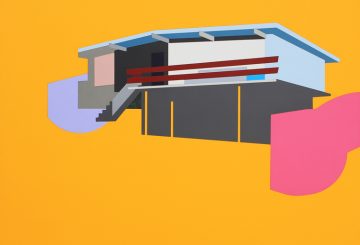At Nicholas Folland’s show at GrantPirrie, Isobel Philip wonders at the strangeness of one thing becoming another…
You do feel as if you have stumbled on a secret lair when you walk down the stairs and into GRANTPIRRIE’s project space gallery, making it an apt space for Nicholas Folland’s show Hideout. The room feels like a secret cubby house, however, the longer you linger and the more time you spend with the peculiar objects that adorn the room’s walls the more you realise that here, things are slightly skewed. This place unnerves.
This becomes quite palpable as soon as you notice the collection of knives that hang one of the walls.
Engraved knives, brass rod, variable installation.
The blades are each raised about an inch off the surface of the wall casting shadows that cascade down the wall appear almost more imposing than the blades themselves. Each knife has a different shaped blade on whose handle an individual name has been carved. These names seem to belong to the knives themselves as opposed to their owners. Floating against the wall they are personified. They have become bodies.
After a while these bodies begin to look distorted or warped. Perhaps this has something to do with the strange medley of blade shapes, which is exaggerated by the mess of intersecting shadows, but even so, the knives appear disfigured. These bodies are contorted and writhing in pain.
It was this paradox that unnerved me, more than the knives themselves. They seemed fragile and vulnerable, not at all violent. It was as if these knives were victims.
Wooden shelf, recast stuart crystal items, doily, branch, 110x40x60cm each.
As I turned my attention to the rest of the objects in this installation I began to realise that everything in this room was marked by paradox or inversion. The two shelves attached to a wall, on which small arrangements of opaque crystals on top of white lace doilies, were being propped up by tree branches that looked ready to collapse.
For me, these pockets of otherness were the most crucial, and indeed beautiful, elements of Folland’s work. I loved those subtle moments of alterity – the warped blades, the dance of their shadows and those crystals. Folland made those crystals by recasting two bowls, wine glasses and a decanter. What was once a vessel, an empty container waiting to be filled, has become a solid mass. Things are not as they should be. They have morphed.
Looking back to the knives I realised that they too had undergone a metamorphosis. Those brutal and sinister implements had quietly transformed into victims. They were not inanimate, they were personified, even gendered, with at least one female: ‘Debby’. These knives had been recast too. They were no longer threatening, they were vulnerable.
In this room things are transfigured and mutate. This is a transformative lair. If a hideout is engineered to conceal, to keep things secret and exclusive, then perhaps what Folland is hiding is this very thing – the metamorphosis that has moved and transformed these objects. And there they sit, waiting to be found.
Nicholas Folland: Hideout
Until 18 December
GrantPirrie



